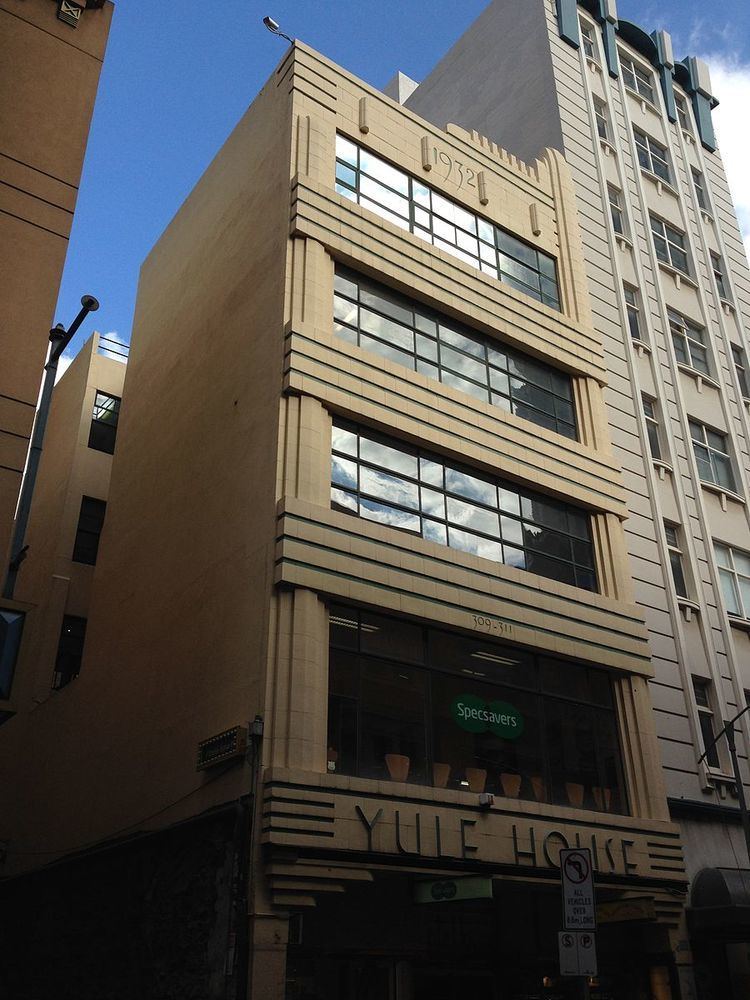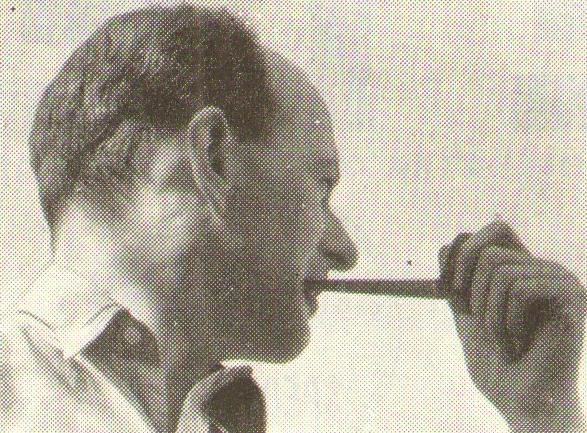Name Rae Featherstone | ||
 | ||
Rae Edwin Featherstone (b.1907-d.1987) was an Australian architect best known for serving as staff architect at Melbourne University. His early work with the firm Oakley & Parkes influenced his later stylistic approach, which was firmly rooted in an early modernist style. He worked for H S Goodhart-Rendel in Europe as Chief Assistant, after which he returned to Australia, working for Stephenson & Turner, and retaining the right to practice on his own. His work on the house Blue Peter (1956) won him national recognition when it was published in the book Best Houses in Australia. He was then appointed his position of senior lecturer at The University of Melbourne, finally achieving the position of staff architect. He later consulted for the Australian University Commission.
Contents
- Biography
- Yule House 1932
- ANZAC House 1938
- Holiday residence for G Nelson Raymond Blue Peter 1956
- Redmond Barry Building 1959 61
- Raymond Priestley Building 1967 70
- References

Biography
R.E.Featherstone (b. 1907, Hawthorn, Australia) began his education at Scotch College, and later Swinburne and West Melbourne Technical Colleges. He then began his internship with Edwin J & C L Ruck, while enrolled at The University of Melbourne for the diploma of Architectural Atelier. Upon completing his qualification, he stayed on at the University as an assistant instructor. He was employed by the firm Oakley & Parkes in 1930 and was involved in the design of Yule House(1932). During this period he retained his right to practice outside the firm and designed a residence for C M Werner, 13 Moorakyne Ave, Malvern. In April 1934 he left Oakley & Parkes to pursue an interest in interior decoration and furniture design in Europe. While in Europe, he was employed in the practice of H S Goodhart-Rendel a position which he held for several years as chief assistant working on cathedrals, hospitals and civic commissions. Upon his return to Melbourne he was employed once more at Oakley & Parkes and worked on the ANZAC House entry sequence (1938) and Phosphate House (1940). He then transferred to the practice of Stephenson & Turner, working on military and civilian hospitals. After the second world war Featherstone returned to The University of Melbourne as a lecturer, in charge of a short course of architectural design for returning servicemen. Then in 1947 when the Faculty of Architecture was established he maintained his position of senior lecturer. Three years later he left on a tour of Europe, America and the U.K. to study post-war building developments. This tour was the basis for his published report "Architectural education in Scandinavia, Western Europe, the United Kingdom, the United States of America". In 1954 the current professor of architecture at The University of Melbourne left for overseas travel, and Featherstone was appointed Acting Professor of Architecture. He had still retained the right to private practice and designed the house known as "Blue Peter"(1956) which gained national recognition when it was published in Neil Clerehan’s book "The Best Australian Houses".
In December 1957, Featherstone was given the position of staff architect at The University of Melbourne and worked on notable buildings on the University's Parkville campus, including the Redmond Barry building and the Raymond Priestley building. He retired as the staff architect in 1972 and was given an honorary Master of Philosophy degree. He later moved to Canberra where he was a consultant for the Australian Universities Commission; in 1978 he retired and returned once again to Melbourne.
Details from Rae Featherstone's first Builder's Payment Certificate Book stub of private work, Certificates 1 - 147 dated 16 August 1940 to 13 June 1956, in the possession of his family. Transcription in progress; one example per property.
Additional Details
Yule House, 1932
When he first began working in the office of Oakley & Parkes Featherstone was involved in the design of the Yule House, 309-311 Little Collins Street. Built in 1932, Yule House is an exceptional example of Moderne Architecture in Melbourne, the "first commercial building in Australia to demonstrate the principles of the emerging Moderne style". The significant influence of Yule House can be seen in many of Featherstones projects.
ANZAC House, 1938
The ANZAC house functions as a library and memorabilia collection for war time diaries, letters and other paraphernalia. This collection is part of the Victorian Collections. The building is a Georgian revival, Palazzo style typical of buildings in the early interwar period. The majority of the building design was done by Stanley Oaks. Featherstone’s involvement with this project specifically pertained to the entrance hall and entry facade itself.
Holiday residence for G Nelson Raymond (Blue Peter), 1956
21 Gulls Way, also known as "Blue Peter" (built prior to the children's show, more likely referring to the nautical flag) gained national recognition when the house was published in ‘Best Australian Houses’ in 1961. Blue peter is a fairly typical example of the more modern and exclusive beach houses of the 1950s. The house consists of two interlocking squares and a triangular raised terrace facing the waterfront. The house was open-plan and could sleep 6 people, with spaces serving multiple purposes. The living room was planned around an elaborate stereophonic installation and served as a living area and dining room with a panoramic view onto the bay, and bay doors that opened onto the triangular terrace. Unfortunately the house was demolished in November 1991, just prior to the Trust councils classification.
Redmond Barry Building, 1959-61
Under his recently appointed position as staff architect of Melbourne University (1957) Featherstone designed North Building in association with Eggleston MacDonald & Secomb. North building, later renamed to the Redmond Barry Building, remains the tallest building on the campus. At twelve storeys high, the landmark tower was constructed in a steel structure slab and podium style system, consisting of shear walls and reinforced concrete columns.
Raymond Priestley Building, 1967-70
Raymond Priestley Building is a large University Administration building, used as office and function space. The building was constructed in a similar way to the Redmond Barry building: concrete slabs with reinforced concrete columns and brick shear walls. Standing eleven storeys high, the five iconic arches branching the building's elevated ground floor undercroft is an example of midcentury Modern Architecture in Melbourne.
